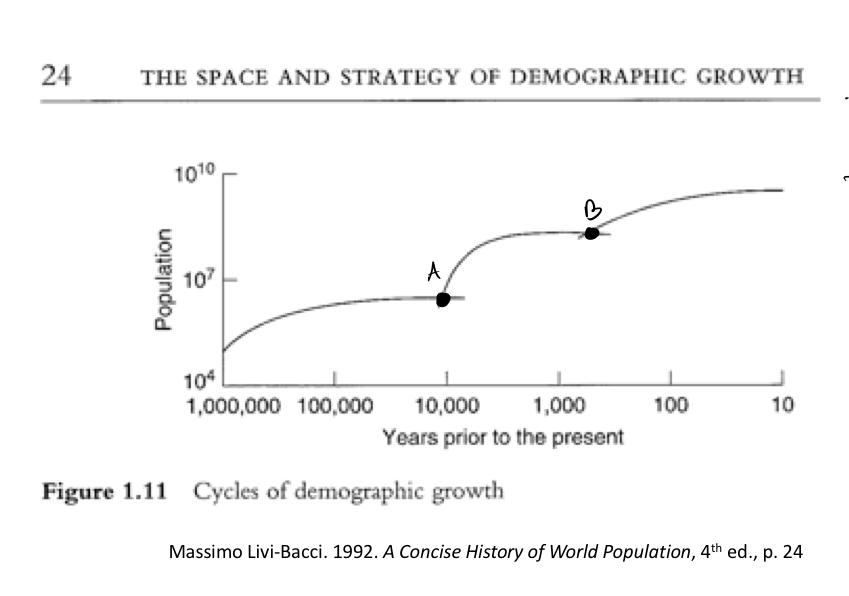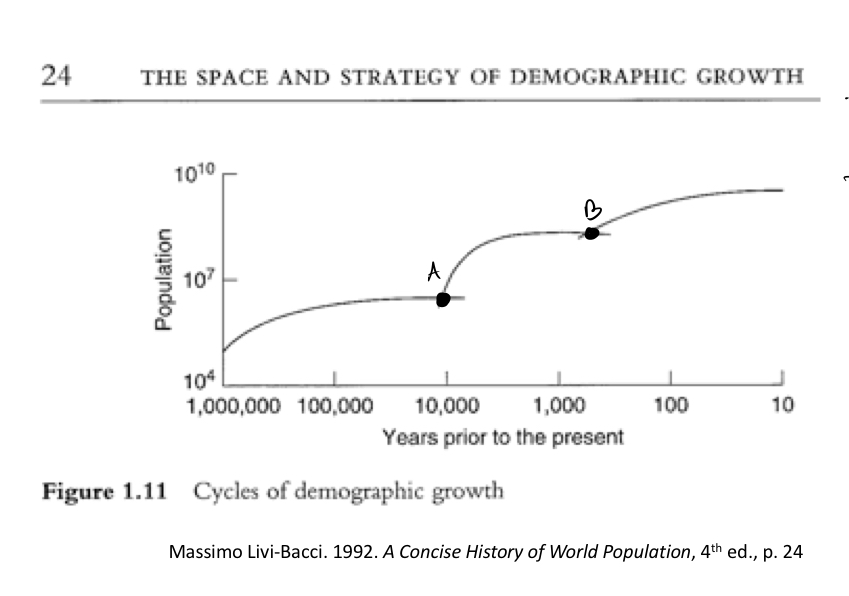Lecture 3: The Neolithic Revolution
1/50
There's no tags or description
Looks like no tags are added yet.
Name | Mastery | Learn | Test | Matching | Spaced |
|---|
No study sessions yet.
51 Terms
when Ingold talks about producing, what connotation does this have?
has connotations of mastery/control
the conventional knowledge that humans set themselves apart from other species by producing their food conveys what?
foragers, who did not produce their food, were not human
what is agriculture?
the production of food using domesticated plants and animals
what is domestication?
process by which wild plants or animals become adapted to humans and the environments they provide
how are animals domesticated?
animals with desired traits are artificially selected and bred so the desirable traits become more pronounced in offspring
generally, domestication entails __________ on humans
dependency
what are three traits associated with domestication?
harvest seed (non-shattering)
increased fruit/grain size
increased palatability (less bitter)
corn was domesticated from
teosinte
what is the difference between modern corn hybrid and teosinte?
modern corn has more rows of kernels, teosinte has two rows of kernels
true or false: domestication originated in one place and then spread elsewhere
false
what is a highly desired trait in wild plants?
immunity/resistance to pathogens
place of origin for plant/animal definition
where it was first domesticated, where their ancestors are found
what plants/animals originated in Eastern North America?
sunflower sumpweed, pitseed, goosefoot, squash
what plants/animals originated in Mesoameica?
maize, beans, squash
what plants/animals originated in Fertile Crescent West?
wheat, barley, cattle, pig
what plants/animals originated in Fertile Crescent East?
barley, sheep, goat
where/when did domestication occur?
occurred in about 20 different places at roughly the same time
occurred at the beginnings of the Holocene (10,000 to 8000 BC)r
what plants/animals originated in Western Savannah?
cowpea, fonio, African rice
what plants/animals originated in North/High Andes?
potato, oca, llama
what is the importance of wild plants for domestication?
there is an abundance of genetic diversity in wild plants- they harbor the traits that breeders look for because they allow new plants to be created
adapted (definition)
biologically adapted artificially through natural selection
people artificially selected certain species with desired traits to bread through which desired traits become more pronounced
heritable changes can be of what variety?
morphological (shape), physiological (anatomy), genetic, and behavioral
non-shattering seeds
seeds that remain on the plant instead of being released when they are ripe
makes harvesting easier and prevents yield loss
de novo domestication
creation of new crops
what are the common characteristics of corn domestication?
from a multi-branched phenotype to a single-branch
concentration of harvestable units to a single crop
where were the origins of corn, wheat, and rice?
corn- Mesoamerica
wheat- Fertile Crescent West
rice- China and Western Savannah (Africa)
Fertile Crescent
origin of many important crops today
how can it be that wheat starts in the Fertile Crescent but moves to places like Great Britain?
the key is the amount of time that passes- seeds have to continue to adapt to the climate as it is moved to different climates
artificial selection- people select the seeds from the plants that are performing the “best”
natural selection- seeds that don’t survive climate, predation, etc. cannot reproduce
what sets the Fertile Crescent apart?
has been a focus of research efforts for hundreds of years
natural conditions led to the ability for preservation
early forms of writing happened earlier so there are written records
true or false: the dominance of the Fertile Crescent is receding
true
how did domestication likely work in the fertile crescent? what were some of the conditions
more temperate climate
delta- edges of the sea as they reach the mouth of the rivers- topography is flat
melting of snow means rivers rise in spring
2x a day the tide goes in and out- raising level of rivers; this leaves the fresh water on the surface (salt water below)
fresh water is pushed onto plains
attraction of wildlife
intense diversity is temporally and spatially distributed meaning there is an abundance of food and knowledge in the same region
increased habitat suitable for plants and animals (increased variety of plants)
agriculture requires
environmental modifications
the up and down sequence of rivers can be seen as a precursor for
irrigation
neolithic innovations
innovations related to agriculture
sickle, ax, adze, grinding ston, terra cotta cooking pot
Neolithic Revolution is conventionally thought of to have started with
the domestication of plants and animals
what are the effects of domestication and Neolithic Revolution on labor?
increased labor (weeding, watering, plowing, processing, etc)
10-100x food energy/unit of land
what are the effects of domestication and Neolithic Revolution on diets and stature?
shift in diets- less meat and more carbohydrates (animals used for traction, manure, and milk; domesticated animals are expensive to maintain)
led to increased anemia and dental caries
reduced stature
what are the effects of domestication and Neolithic Revolution on life expectancy? why the disparities?
reduced life expectancy for women, increased for men
due to increased fertility women were at greater risk during childbirth- higher mortality
what happens to the average height of men and women from the Paleolithic vs Neolithic era?
average height decreases due to changes in diet and nutrition
what is a theory for why there was a motivation for domestication?
there was a decrease in fertility

what do the inflection points represent?
series of rapid growth and then a plateau

what does point A represent?
the Neolithic Revolution- the domestication of plants and animals (~10,000 years ago)
total fertility rate
the average number of total (lifetime) births per woman in a population
growth rate
the percentage growth of a population per year
life expectancy
the average life span of a member of a population at birth
in the shift from paleolithic to neolithic, what happens to population growth rate, total fertility rate, and life expectancy?
population growth rate increases slightly
total fertility rate increases (from 6.5 to 7.5)
life expectancy decreases (from about 18 to 16 1/2)
why would life expectancy decrease during the Neolithic Revolution?
high infant mortality
higher population density means more opportunity for diseases
the rate of population growth was slow prior to agriculture, the doubling rate
increased (between 1500-1900 populaiton incresaes 4 fold)
what is the dominant narrative presented by Graeber and Wengrow about the Neolithic Revolutions?
civilization is attributed to agriculture
agriculture means more food, which means you can feed more people, having more people means that not everyone has to grow food (division of labor)
the conventional narrative of the Neolithic “Revolution” has what implication?
those that did not practice agriculture were not civilized and therefore not human
true or false: evidence suggests that the convention narrative of the Neolithic “revolution” is correct
false